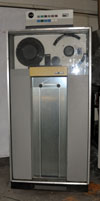
Before disk storage there was Magnetic Tape Storage.

The tape was a strip of thin plastic 1/2" wide, 2400ft long,
and coated in a ferrouse oxide layer that was capable of being magnetized
one way or the other. One way was a ONE the other was a ZERO.
Here is a photograph of a magnetic tape.

A READ/WRITE head from a magnetic tape drive.
There were nine tracks of bits written at a density 1600 bpi (Bits Per Inch).
(Later Models could write at 6250 bpi.)
The nine bits were a byte of 8 bits plus a parity bit.
To understand this tape drive you have to know several things:
| 1. | The data arrived as a stream of bytes to be recorded on the tape with no buffering. The magnetic tape had to be up to recording speed when the data arrived. (The recording speed was about 15 ft/sec) (The recording speed combined with the data rate determined the recording density.) |
| 2. | The stream of data is of finite length and called a block. |
| 3. | Between the blocks is an interblock gap. The second half of the interblock is used to get the tape up to recording speed and the first half to slow it to a stop. The interblock gaps are of fixed length whereas the blocks of data are of variable length. |
| 4. | The interblock gap has to be as small as possible. (It was 0.6 inch.) |
| 5. | The tension on the tape had to be as small as possible to avoid stretching the tape and losing the data. |
The small interblock gap was achieved in the following way:
How big were the blocks written to the magnetic tape?
If each block was just a punched card image of 80 bytes it would use
80/1600 + 0.6 inch of tape = 0.65 inch.
so in 2400 ft of tape there would be 44307 blocks totalling 3.5 MByte.
If each block was 100 punched cards of length 8000 bytes it would use
8000/1600 + 0.6 inch of tape = 5.6 inch
so in 2400 ft of tape there would be 5142 blocks totalling 41 MByte
ten times as much.
Going to 80,000 byte blocks, a 1000 punch cards, gave a total of 45 MByte
not much more than a 100 punch card blocks.
When you consider that the memory of these computer was 1 - 8 MByte
there was a compromise. Block size was about 5" (13cm) 8000 bytes.
Another aspect of magnetic tape drive, as well as punch card and paper tape,
is that they were sequential access, not direct access like a disk drive,
to read a block of data you had to read all the preceding blocks.
This had a profound effect on how data was stored and processed.
The tape drive was a small wardrobe size 76cm x 75cm x 170cm
it weighed 370kg and used 1.8kW of electricity. (that is an electric kettle's worth.)
It could not operate without its Control Unit
another small wardrobe size cabinet, 91cm x 91cm x 152cm
weighing just 280kg and using 1.8kW.
This control unit could support up to 8 tape drives.